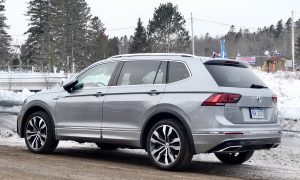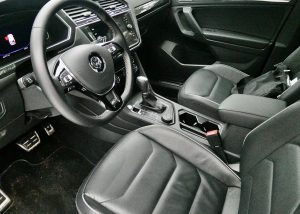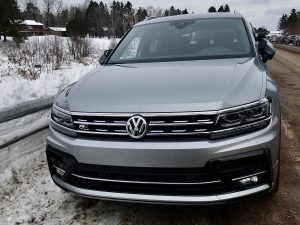Tiguan goes to greater lengths to impress
By John Gilbert
The tradition of making cosmetic changes to make a new car look artificially new appears to be over. Auto companies have finally realized that if they build a model with a widely accepted design, staying with it is not a bad thing.
That seems to have been the belief of Volkswagen for years, particularly when you consider the Beetle, or the Golf. It also has had an impact on VW’s compact Tiguan SUV, which is more into refining upgrades than startling alterations.
I’ve written about the Tiguan before, because it is a solid, substantial, safe SUV, capable of hauling a good amount of stuff as well as people, and giving you a secure feeling of driving and riding, which is important to families. Over two generations of Tiguans, there wasn’t a lot of change for change sake, but in 2018, VW made a somewhat startling move.
The decision was made to lengthen the somewhat stubby Tiguan by more than a foot, and offer a their-row passenger seat as an option. The seats fold down, greatly expanding luggage capacity, and it made the third-generation Tiguan stand out for having grown substantially.

The Tiguan revisited Hwy. 61 to attend the Norwegian winter festival of Julebyen in Knife River, Minneaota.
VW did a great job of stretching out the body and making that extra room useful on the inside, without looking grotesquely bigger on the outside. It was almost unnoticeable unless you parked one alongside one of the first two generation models for contrast.
At first, always seeking the most compact versions of anything, my impression was that the new and longer Tiguan made me appreciate the older and shorter model more. Both were sold, but the shorter one seemed sportier. It was evident, however, that the shorter model would only exist until the supply ran out, then all Tiguans would be built longer.
I recently had the chance to spend a week in Northern Minnesota with the 2020 Tiguan, and we did find ways to put the extra storage space to good use. The model we tested was the SEL R-Line, loaded up and second only to the SEL Premium in VW’s five-model pecking order.
For 2020, the Tiguan SEL adds some technology and features, many of them dealing with connectivity, and safety. Blind spot monitoring, rear cross-traffic alert, forward collision warning and emergency stopping aid, pedestrian detection, the optional third-row seat, and a Fender premium audio with nine speakers added to the pleasant environment of the Tiguan SEL.
The Tiguan price is comparatively steep, but spending up to $38,000 assures you of comfort and convenience added onto the standard safety. The Tiguan hasn’t grown so much that the tried and trusty 2.0-liter dual overhead camshaft VW 4-cylinder can’t handle the extra size. Especially when bolstered by a turbocharger to attain 184 horsepower. The test vehicle also had 4-Motion, which is VW’s all-wheel-drive system.
The test Tiguan also added remote start and rain-sensing wipers, along with wireless charging, the latest cell-phone compatibility, and a large sunroof, plus a 1,500-pound towing maximum, which is adequate for fishing boats or light camping trailers.
Competition for the Tiguan comes from vehicles such as the Mazda CX-5 — one of my personal favorites — and the Honda CR-V, Nissan Rogue, and Ford Escape, among others. The proliferation of compact SUVs makes this a crowded segment, although as a longer vehicle, the Tiguan can also move up to challenge larger midsize SUVs such as the Explorer and the General Motors variants, and Tiguan still holds its head high as a premium entry.
Driving the Tiguan gives you the feeling of security in all situations. We had a good old-fashioned North Shore snowstorm during my time with the Tiguan, and it always provided a calming effect — safety, security, and the solid confidence in its ability to get you through anything to get home.
Comfort from the leather bucket seats of the upper-crust SEL R-Line, with its sporty touches, and the third row seat is not to be taken lightly. It’s not particularly roomy for adults in the way-back, but it is capable, and with the 4-Motion models, you get 5-7 occupants. With all three rows in place, there is 12 cubic feet of storage behind the third row; folding down the third row obviously increases that, and if you fold down both the second and third rows, you have 65.7 cubic feet of storage.
In its renovated product line, Volkswagen is streamlining things with brisk and efficient engines. The 2.0 Turbo is the only one available in the Tiguan, and it is capable of being quick enough and still delivering mid to high 20s in miles per gallon. Some of the modern touches are more than gimmicks, things like lane-departure warning and rear cross-traffic alert, and while you get a larger navigation screen with the SEL, you appreciate those features once you drive with them.
In years past, there might have been two different 4-cylinder engines and a V6 available, but the do-all 2.0-Turbo overlaps its assets to cover all demands. You can find faster SUVs, and more economical ones, but it difficult to think of one that offers both sufficiently, plus the size, room, safety and security, and the promise of that solid build and style.
Style is purely subjective, of course, but in my mind, the sleek grille and the smooth look without being gimmicky are complemented by a neat crease along the side. And if the realization occurs to you that you needn’t trade in your vehicle every two years to keep up with always altered designs, you admire the stately look of the new Tiguan even more.





 John Gilbert is a lifetime Minnesotan and career journalist, specializing in cars and sports during and since spending 30 years at the Minneapolis Tribune, now the Star Tribune. More recently, he has continued translating the high-tech world of autos and sharing his passionate insights as a freelance writer/photographer/broadcaster. A member of the prestigious North American Car and Truck of the Year jury since 1993. John can be heard Monday-Friday from 9-11am on 610 KDAL(www.kdal610.com) on the "John Gilbert Show," and writes a column in the Duluth Reader.
John Gilbert is a lifetime Minnesotan and career journalist, specializing in cars and sports during and since spending 30 years at the Minneapolis Tribune, now the Star Tribune. More recently, he has continued translating the high-tech world of autos and sharing his passionate insights as a freelance writer/photographer/broadcaster. A member of the prestigious North American Car and Truck of the Year jury since 1993. John can be heard Monday-Friday from 9-11am on 610 KDAL(www.kdal610.com) on the "John Gilbert Show," and writes a column in the Duluth Reader.